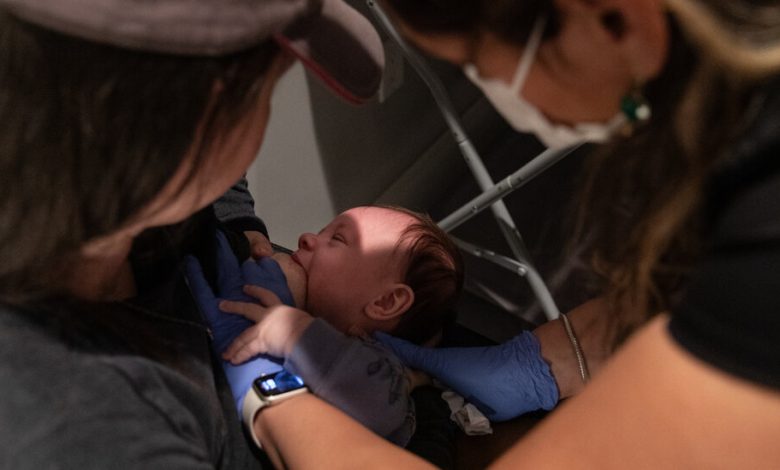What Parents Should Know About Tongue-Tie Releases

It’s an increasingly common scenario faced by new mothers across the country: A lactation consultant examines their newborn and suggests that cutting a “tongue-tie” may ease their difficulty breastfeeding.
The quick procedure, known as a tongue-tie release, involves a dentist or doctor snipping a tight band of tissue connecting the tongue to the bottom of the mouth. In recent years, lactation consultants and dentists have aggressively promoted the procedures, even for babies with no signs of real tongue-ties and despite a modest risk of complications, a New York Times investigation recently found.
Many parents, anxious and exhausted, agonize over whether to go through with the procedure, which is often done with a dental laser. Dentists, lactation consultants and pediatricians often disagree about whether it will help.
The Times spent months investigating the evidence behind tongue-tie releases and talking to dozens of experts. Here’s what parents who are considering the procedure should know.
Breastfeeding a newborn can be hard, even when it’s going well.
The early days of nursing can be rough. One recent survey of more than 1,400 women found that nearly 40 percent struggled with at least one complication, such as latching pain, cracked nipples or sore breasts.
Those early hurdles can be discouraging, especially for new mothers surviving on little sleep. The good news: Many mothers report that breastfeeding often gets easier with time, as both they and their babies become more experienced.
Lactation consultants can provide support in those early days of nursing by suggesting ways to position the baby that will decrease a mother’s pain. Consultants have become more accessible since Obamacare mandated that health insurers cover their services. Hospitals and nonprofits like the La Leche League offer support groups for nursing mothers as well.
A small share of babies are born with tongue-tie, which might make breastfeeding more difficult.
Pediatricians say that a true tongue-tie is easy to identify. When the baby tries to lift the tongue, it forms a heart shape as the middle is pulled down. Other babies with tongue-tie cannot extend their tongues beyond their lower teeth.
Various studies have estimated that 4 to 11 percent of babies have tongue-tie. If you suspect a tie and are having trouble nursing, a pediatrician or ear, nose and throat specialist can weigh in after physically examining your baby. (Certified lactation consultants are not supposed to diagnose tongue-ties without medical degrees, but can refer babies to specialists.)
Doctors emphasized to The Times that many tongue-ties are harmless. The procedure is only warranted, they said, when the tongue-tie is pronounced and the mother is having difficulty nursing.
Small studies have shown that tongue releases can reduce nipple pain.
Some providers tout tongue-tie releases as cure-alls for everything from sleep apnea and speech delays to cavities and constipation.
Little evidence supports those claims.
In 2017, after scouring the medical literature for the best studies on tongue-tie releases, researchers found five high-quality studies that included a total of 302 infants.
The studies showed that tongue releases could reduce nipple pain. But the data showed no effects on a baby’s ability to eat.
A 2015 study by researchers at Vanderbilt University came to a similar conclusion: Tongue-tie releases led to “mother-reported improvements in breastfeeding, and potentially in nipple pain.”
No rigorous studies have shown that the procedures affect a baby’s sleep or future issues like speech.
One major challenge for those studying the procedures is that breastfeeding often gets easier with time. While many mothers report a better experience nursing after the procedure, it can be hard to tell if that is the result of the tongue-tie release.
Bring a skeptical eye to cheek and lip-ties.
Over the past decade, some dentists and lactation consultants have begun to recommend cutting “oral ties” in other parts of the mouth. Those include lip-tie — when tissue tethers the lip to the gum — and buccal-tie, so named for the webbing that connects the cheeks to the upper gums.
Some also recommend an elaborate aftercare regimen, telling parents to periodically sweep their fingers under their baby’s tongue and around their mouth to prevent the tissue from reattaching.
Pediatric ear, nose and throat specialists said that they rarely, if ever, clipped lip or cheek-tie in babies because there is no solid evidence that the ties impede breastfeeding.
These doctors strongly recommend seeking a second opinion if a medical provider has recommended this type of care. The American Academy of Otolaryngology put out a consensus statement in 2020 stating that “surgery to release a ‘buccal tie’ should not be performed” and that there is “no evidence” to support stretching or massaging the wound after the release.
Complications are rare, but they can happen.
The vast majority of dentists and doctors The Times interviewed agreed that tongue-tie releases, which take only a minute or two, have a low risk of harm.
But complications do happen, and they can be serious. It’s hard to estimate a precise rate of problems because no one systematically tracks them. Some pediatric ear, nose and throat specialists working at children’s hospitals said they see two or three tongue-tie complications each year.
Doctors said the most common problem was oral aversion, in which pain causes babies to become extremely sensitive to anything entering their mouth. In serious cases, babies will refuse to eat and will require hospitalization.
While some dentists and doctors will often highlight the benefits of tongue-tie releases, Dr. Soham Roy, chairman of the pediatric ear, nose and throat practice at Children’s Hospital Colorado, says he encourages parents to ask questions about the risks as well.
“There is no surgical procedure without risk, and parents deserve that information before they sign up,” he said.
